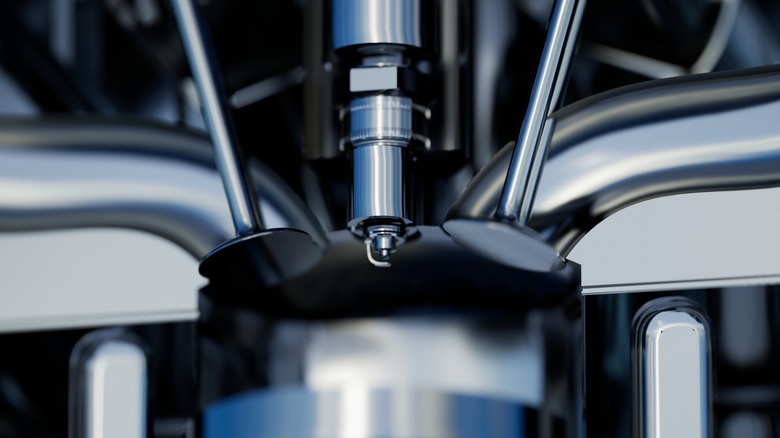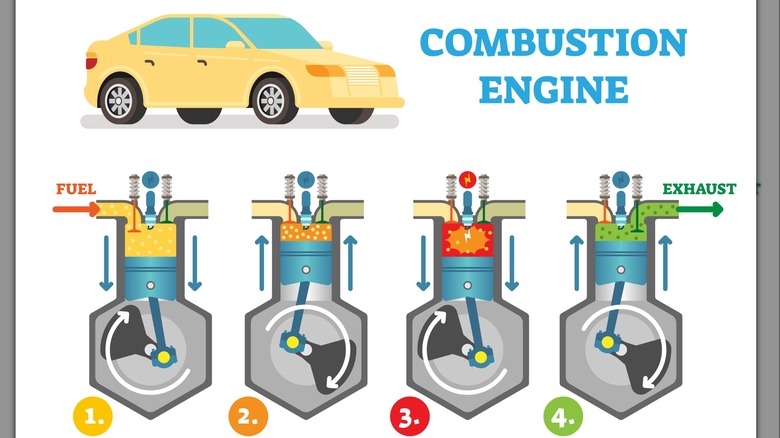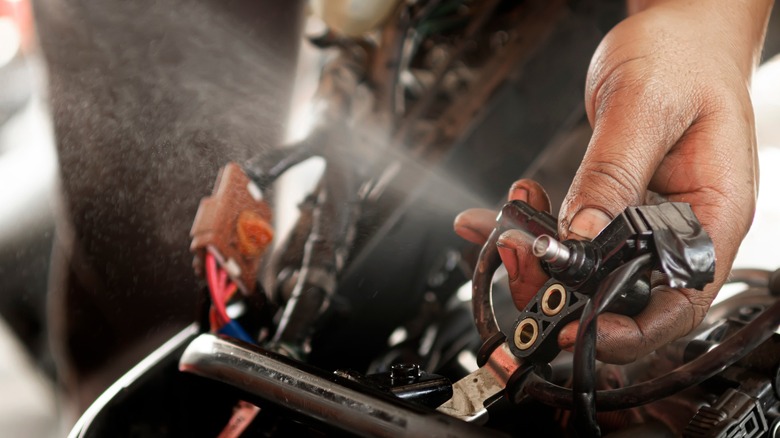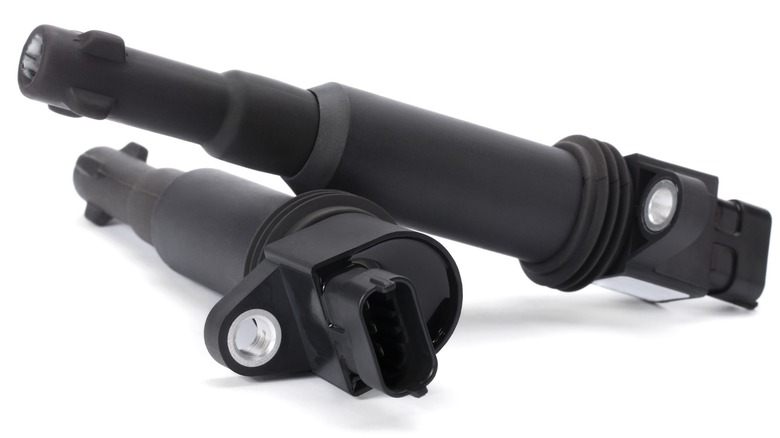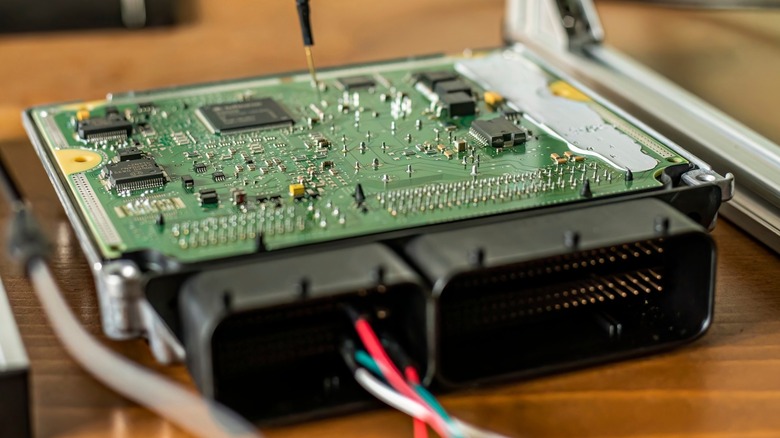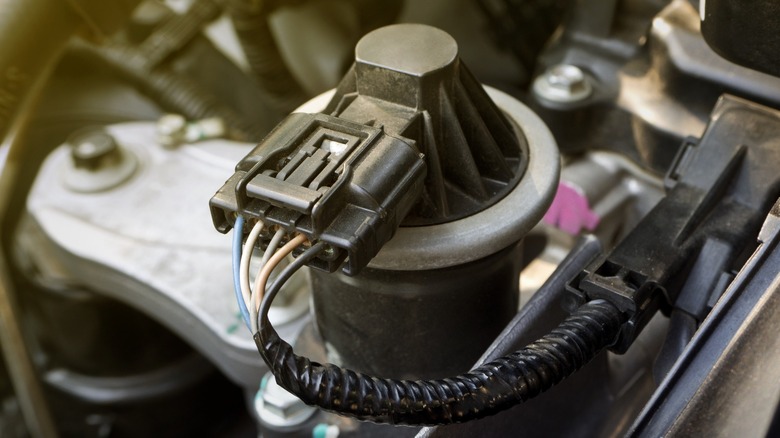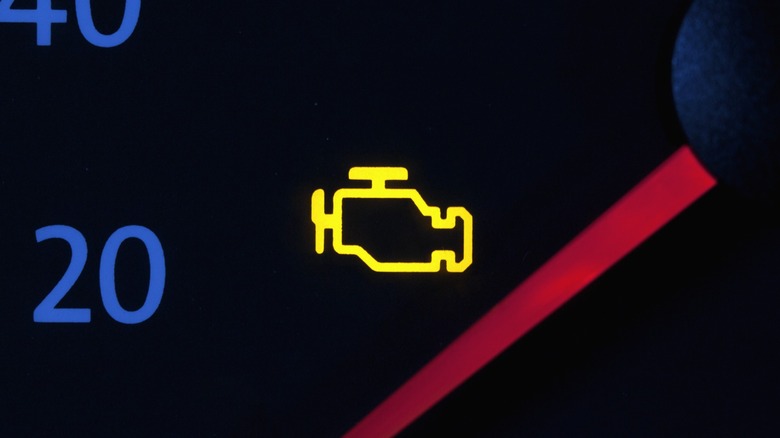10 Common Causes For An Engine Misfire (And If You Can Fix Them At Home)
When I attended technical school studying automotive service technology many years ago, among the first things my instructor taught us was the basic principles of how an engine works. These principles as applied to most engines in cars and light trucks follow what is known as the Otto cycle. This is a four-stroke cycle that governs the process of how engines turn the stored energy in gasoline into the kinetic energy moving the car. This was described by the instructor as suck, squeeze, bang, blow, referring to the four cycles of intake, compression, combustion, and exhaust. Regardless, it can be extremely frustrating when one of these cycles fails to occur in your own vehicle.
A common condition you may have heard of when one of these cycles fails is called a misfire. Whether you have experienced it yourself, if you are a "Top Gear" fan and have watched all of the best episodes, you have certainly heard Richard Hammond blame a slow track time on one — it's one of the more memorable gags from the show. While it can be funny as a running gag on a TV show, when there are no cameras and you are experiencing a misfire on your own car, it becomes far less amusing. In fact, a misfire left untreated can cause long term damage to the engine. This may have you wondering what causes a misfire and what you can do about it.
What is a misfire?
When the combustion, or bang, part of the engine cycle fails to occur, it is called a misfire. The most noticeable symptoms of a misfire are an irregular idle or loss of power when the misfire is a repeating occurrence. Occasionally, a single random misfire can happen, but those can be difficult to diagnose and are generally not a cause for concern. Furthermore, misfires are more noticeable with fewer cylinders. A 4-cylinder car loses 25% of its power from a misfire while a the V10 Triton in a Ford heavy-duty truck, for example, only loses 10%.
Regardless of what size engine you have, misfires almost always cause an irregular idle. The sometimes erratic rpm will usually be accompanied by shaking that can be felt throughout the car, often smoothing out as the engine speed increases, even with reduced power. While your car will likely accelerate and get to speed, it will take longer than usual, require using more throttle, and may feel as though the engine is fighting itself to get to speed. In a sense, it is. One cylinder is not performing and the rest are working harder to compensate. No matter what symptoms from a misfire exist, it is a problem that requires attention as soon as possible.
Faulty fuel injector
Obviously, fuel is a requirement for your car to run. It needs to combine with oxygen and be ignited for combustion to occur. Misfires can happen when a problem with the fuel injection system exists, and there are many reasons this can happen.
The most common reason a fuel injector fails to function comes from being clogged with sediment from fuel. While cars and trucks have fuel filters, sometimes they don't do their job or the sediment is built up over time from microscopic particles. The injector nozzle atomizes fuel with an array of tiny holes which can get clogged with the tiniest of particles. Other reasons for this condition stem from faulty wiring, a mechanical failure within the injector, or problems with the controller. A blockage of just 8% to 10% can cause a misfire.
If you suspect you have clogged injectors, a variety of fuel system cleaners are available to help dislodge the debris, although results may vary. Beyond using one of these treatments, most fuel injector related misfires require professional diagnosis and repair.
Faulty ignition coil
The firing of the spark plug is crucial to achieving combustion in gasoline engines. Once the fuel and air are compressed in the combustion chamber, the spark plug, fired at the exact right moment, initiates combustion, sending the piston back down the cylinder, thus turning the energy stored in fuel to kinetic energy. When the spark plug is inoperable, a misfire occurs.
In modern engines, an ignition coil is installed directly above the spark plug and connected by a well-insulated boot. The ECU sends a signal to the coil, which transforms 12 volts of direct current into thousands of volts to cause an arc of electricity to jump across a gap of about .0040" to ignite the fuel. Coils produced around 10,000 volts in the early days but have evolved to deliver as much as 100,000 volts thanks to modern engineering. Sometimes, an ignition coil fails completely, requiring replacement.
On many cars, replacing an ignition coil is an easy task requiring no more than half an hour of work. You may be lucky enough to have a car with an easily accessible coil held in by a single 10 mm bolt. These you can replace yourself once you determine which one is misfiring, and a trouble code from the ECU can usually help figure that out. Unfortunately, other cars make it rather difficult to replace the coil, requiring many parts to be removed to get to them. Only an experienced pro should attempt such a procedure.
ECU malfunction
Since modern fuel injected cars are controlled by computerized controllers, everything within that system needs to be functioning normally or one of many symptoms may be detected, including misfires. Unfortunately, issues stemming from malfunctions of the electronic control unit (ECU) can be difficult to diagnose. Further complicating diagnosis can be the high price of replacing an ECU, which can have a home mechanic and even some professionals hunting for a less costly solution, though the efforts may end up wasted.
The computer code programmed to keep your engine running effectively and efficiently is both complex and precise while being compact, efficient, and stable. It coordinates inputs from a variety of sensors, calculator conditions present and conditions desired, and sends signals to fuel injection, ignition coils, and other systems to execute its program. This is a continuing process with calculations performed in milliseconds while continuously changing due to conditions.
The ECU can fail, which is one of many causes that will shut down your car. Sometimes water can seep into the housing and short electronic circuits while vibrations can cause loose connections within. Furthermore, electrical spikes may damage circuits, a particular danger from an improper jump starting procedure. This can manifest in unexpected ways, and misfires are but one of many possible symptoms. Unfortunately, there is no simple diagnosis and it will require a professional's touch, usually happening after exhausting all other avenues.
Damaged or corroded spark plug
When all the systems of your engine are in order and working but a misfire in one cylinder remains, it can be due to a worn, corroded, or otherwise failed spark plug. On cars of the past before modern electronics infiltrated the engine bay, this would be a common cause of a misfire, especially since carburetors fed fuel to all cylinders while a single ignition coil fed all spark plugs through a distributor. If either one had a problem, the engine would likely not run at all. Spark plugs often wore out, causing misfires and needed regular replacement.
Modern spark plugs are much improved from those of previous generations. They last longer and have lower failure rates, often going 100,000 miles or more while old ones were changed every 30,000 or 40,000 miles. This is due to advances in metallurgy and materials of much greater strength being used to manufacture them.
All of this is to say that a bad spark plug definitely can cause a misfire, but it is not nearly as common as it once was. If the misfiring car has more than 100,000 miles and either the plugs are original or you have no knowledge if they have ever been changed, check the plug on the problem cylinder. Many spark plugs are very affordable, making a change relatively low risk. However, this will rarely cure a misfire on modern cars.
Vacuum leak
When the pistons in your engine move down the cylinder on the intake stroke, they draw in air through the intake manifold. This process creates a vacuum within the intake, something engineers have taken advantage of to operate other systems and accessories for decades. Cruise control on cars before the computer age utilized vacuum and power brakes continue to rely on it today. Emissions controls and fuel injection systems also rely on vacuum to function properly. Cars from a previous generation came with a spaghetti-like maze of vacuum hoses under the hood. The innovative Honda CVCC engine technology introduced in 1972 used a complex maze of vacuum tubes that could induce nightmares in mechanics of the day.
When a leak develops in any of these vacuum lines or the gasket for the intake itself, it can cause a misfire. Sometimes this manifests as random misfires or it can target a specific cylinder based on its location. It can also be an incredibly frustrating problem to diagnose. The most basic DIY method is to use a can of carburetor cleaner and spray it in likely locations for a leak, and if the engine speed changes, you have found it. Besides that, a visual inspection is the easiest but least effective, and other methods require sometimes costly specialty tools, such as a smoke machine leak tester.
Emissions system failure
In attempts to continuously lower the polluting molecules exiting tailpipes, automotive engineers have added increasingly sophisticated and complex emissions control equipment to the engines in cars. These systems can be found all over from the air intake to the exhaust, and they operate using engine power, vacuum, and electricity. Most of them are computer controlled with sensors that can set a trouble code when returning faulty or erroneous signal inputs. Faulty emissions controls can also cause misfires, often but not always because the component failure itself causes a vacuum leak. Conversely, a misfire can also cause malfunctions in the emissions system.
Most emissions system failures will set a trouble code, offering a technician a relatively clear path to diagnosing and repairing the problem. However, this is not always the case. Sometimes a failure of parts in the exhaust gas recirculation (EGR) system or the positive crankcase ventilation (system) can alter how much fuel is directed to one or more cylinders, constrict exhaust flow, or one of many other malfunctions.
Unfortunately for the average car owner, unless you can see something obviously amiss upon visually inspecting your engine, a professional evaluation will be needed. Furthermore, there is no way to anticipate the cost or complexity of the job as emissions controls vary widely from one car to another, and many components are hidden beneath multiple layers of other parts, requiring hours to access.
Is a misfire harmful?
All continuing misfire conditions make for a frustrating driving experience but some are more serious than others. Potential for additional damage stems from the type of misfire occurring. Generally, misfires resulting from a vacuum leak or emissions system failure will not directly cause permanent damage on their own. However, either of these issues will create conditions in which the engine is not functioning properly, resulting in higher emissions. In this case, the permanent damage may not be to the car, but the environment.
Misfires resulting from a failure of fuel injectors are unlikely to cause permanent damage. However, when the spark plug fails to ignite, serious damage can come quickly. With certain running conditions in which ignition is not happening, modern cars will display a flashing check engine light (CEL). If you see this, get the car to a safe place and shut it off immediately. Fuel pouring through the engine without being burned up and accumulating on the red hot catalyst in the catalytic converter will ignite inside the converter and melt the catalyst, destroying the precious platinum, palladium, and rhodium contained within. Once that happens, the converter becomes clogged, the engine will not run, and the converter will be irreparably harmed. Converters can run into the thousands, saving them should be a priority. I cannot stress this enough: when the CEL is flashing, shut down your car immediately.
No matter the cause of a misfire, you should check into it immediately and repair it. Continuing to operate an engine with a misfire is a bad habit that can ruin your engine. Sometimes the repairs are cheap and easy, but more importantly, your engine will run better and last longer in proper operational condition.
